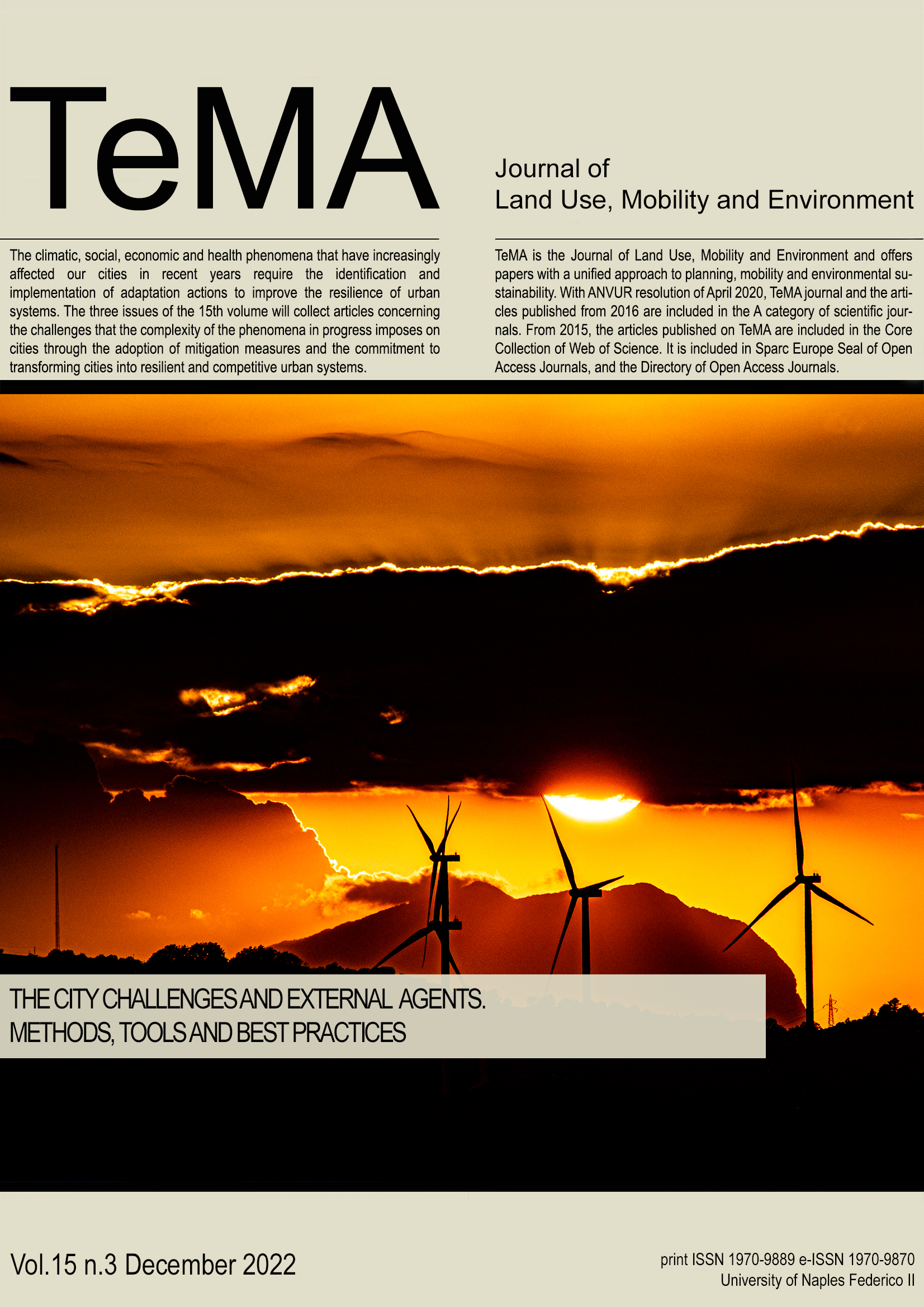Urban sustainable development: the cost of pursuing SDGs
Abstract
Starting from the relationship between urban planning and mobility management, TeMA has gradually expanded the view of the covered topics, always following a rigorous scientific in-depth analysis. This section of the Journal, Review Notes, is the expression of a continuous updating of emerging topics concerning relationships among urban planning, mobility and environment, through a collection of short scientific papers. The Review Notes are made of four parts. Each section examines a specific aspect of the broader information storage within the main interests of TeMA Journal. In particular, the Economy, business and land use section aims at presenting recent advancements on relevant topics that underlie socio-economic relationships between firms and territories. The present note aims at highlighting the costs associated to the UN Sustainable Development Goals. The hight investment costs and the gap that still divides cities from the achievement of the sustainable targets shed lights on the need to incentivize both public and private investments.
Downloads
References
Battarra, R., Zucaro, F., & Tremiterra, M. R. (2018). Smart mobility and elderly people. Can ICT make the city more accessible for everybody?. TeMA-Journal of Land Use, Mobility and Environment, 23-42. https://doi.org/10.6092/1970-9870/5768.
Bianconi, F., Clemente, M., Filippucci, M., & Salvati, L. (2018). Regenerating Urban Spaces: A Brief Commentary on Green Infrastructures for Landscape Conservation. TeMA Journal of Land Use Mobility and Environment, 11(1), 107–118. https://doi.org/10.6092/1970-9870/5216
Burlando, C., & Cusano, I. (2018). Growing Old and Keeping Mobile in Italy. Active Ageing and the Importance of Urban Mobility Planning Strategies. Tema-Journal of Land Use Mobility and Environment, Special Is, 43–52. https://doi.org/10.6092/1970-9870/5756
Cavalli, L., Eni, F., Mattei, E., Italia, S., Lizzi, G., & Toraldo, S. (2020). L’Agenda 2030 in Italia a cinque anni dalla sua adozione: una review quantitativa. Reports.
Errigo, M. F. (2018). The Adapting City: Resilience Through Water Design in Rotterdam. TeMA, Journal of Land Use, Mobility and Environment, 11(1), 51–64. https://doi.org/10.6092/1970-9870/5402
Filho, W. L., Dinis, M. A. P., Ruiz-de-Maya, S., Doni, F., Eustachio, J. H., Swart, J., & Paço, A. (2022). The economics of the UN Sustainable Development Goals: does sustainability make financial sense? Discover Sustainability, 3(1). https://doi.org/10.1007/s43621-022-00088-5
Guida, C., & Caglioni, M. (2020). Urban accessibility: the paradox, the paradigms and the measures. A scientific review. TeMA Journal of Land Use Mobility and Environment, 13(2), 149–168. https://doi.org/10.6092/1970-9870/6743
Molavi, M. (2018). Measuring Urban Resilience to Natural Hazards. TeMA, Journal of Land Use, Mobility and Environment, 11(2), 195–212. https://doi.org/10.6092/1970-9870/5485
Shirgir, E., Kheyroddin, R., & Behzadfar, M. (2019). Defining urban green infrastructure role in analysis of climate resilience in cities based on landscape ecology principles. TeMA Journal of Land Use Mobility and Environment, 12(3), 227–247. https://doi.org/10.6092/1970-9870/6250
UN Habitat. (2020). The cost of making a city sustainable. Retrieved from: https://unhabitat.org/news/27-apr-2020/the-cost-of-making-a-city-sustainable-measuring-the-financial-cost-of-meeting-sdg
Vorisek, D., & Yu, S. (2020). Understanding the Cost of Achieving the Sustainable Development Goals. World Bank Working Paper, (February). https://doi.org/10.1596/1813-9450-9164
Copyright (c) 2022 TeMA - Journal of Land Use, Mobility and Environment

This work is licensed under a Creative Commons Attribution 4.0 International License.
Authors who publish in this journal agree to the following:
1. Authors retain the rights to their work and give in to the journal the right of first publication of the work simultaneously licensed under a Creative Commons License - Attribution that allows others to share the work indicating the authorship and the initial publication in this journal.
2. Authors can adhere to other agreements of non-exclusive license for the distribution of the published version of the work (ex. To deposit it in an institutional repository or to publish it in a monography), provided to indicate that the document was first published in this journal.
3. Authors can distribute their work online (ex. In institutional repositories or in their website) prior to and during the submission process, as it can lead to productive exchanges and it can increase the quotations of the published work (See The Effect of Open Access)

